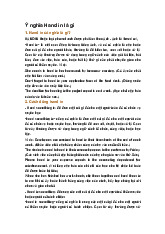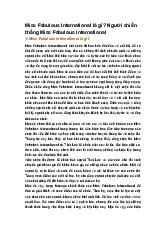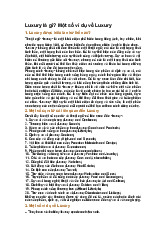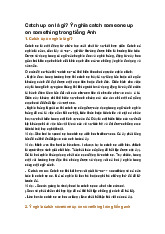


Preview text:
CHAPTER 4: SOME SUGGESTIONS ON APPLYING SHADOWING TECHNIQUE
4.1 Object should apply Shadowing technique
4.2.1 Suggested procedure for practicing the Shadowing technique by yourself
4.2.1 Stimulating the brain with sound
Shadowing allows you to train your articulators to produce sounds more
accurately. In a real conversation, you have to organize your ideas, find the right
words and formulate phrases. But by imitating someone else’s speech, you can just
focus on the sounds of the language. Select a piece of audio
Find a short piece of audio (max. 5 minutes) with just one person speaking.
It doesn’t have to be a native speaker, but they should be proficient.
4.2.2 Study on transcript
Shadow the audio with a transcript This is the easier version of shadowing: .
speaking with the audio while also reading a transcript. This helps you to see the
words as you’re repeating them. If you’re a beginner or lower-intermediate English
learner, this is a great option for you
4.2.3 Listen and practice each sentence
Before you start shadowing, listen to the audio at least once to get used to the
speaker’s accent, rhythm and intonation. Don’t worry if you don’t understand
every word, but if it’s too fast or complex, look for an alternative. Then you will
listen to each sentence and imitate the pronunciation and intonation of the speaker.
* If you’re a bit more advanced, you can skip straight to this step and do
shadowing without the transcript. The focus here is on simply listening and then
mimicking what you hear. Your focus is on mimicking the sounds; it’s not so much on what is being said.
4.2.4 Practice the whole paragraph
Now is the time for you to practice the whole paragraph according to the speaker,
please pay close attention to their pronunciation and intonation to speak in the most
accurate way. It can be challenging to begin with, but try to repeat what the speaker
says as quickly and as accurately as possible. Start by doing 20-30 seconds and if
you get stuck, just stop the audio and start again. Remember, we’re not really
concerned with meaning, you’re just trying mimic speaker’s voice. 4.2.5 Record yourself
Once you’ve practiced and you feel more confident, try recording yourself.
Listen to the audio through your headphones and record your voice using your
computer or smartphone. Do not forget to listen to your recording and compare
your speech to the original audio.
CHAPTER 5: SOME RESOURCES USED IN SHADOWING
5.1 Use the listening files in the textbook in class
Basic Ielts Listening, Focus on Ielts, Integrated Language Skill in English, Elementary Listen, …
5.2 Through famous vloggers
You find the vloggers talking about your favorite field or event on social networking platforms.
5.3 Through podcasts, videos or channels
You can search on Spotify, Youtube, Netflix, TED Talk, VOA News, BBC News,
Brishtish Counncil, Youlish, English speeches with subtitles, Cake, Shadowing
app, VoiceTub or even radio shows. CONCLUSION REFERENCES
https://oxfordhousebcn.com/en/shadowing-improve-fluency-at-c2-level/
Hamada, Y. (2018). Shadowing for pronunciation development: Haptic-shadowing
and IPA-shadowing. Journal of Asia TEFL, (1), 167. 15
Hsieh, K. T., Dong, D. H., & Wang, L. Y. (2013). A preliminary study of applying
shadowing technique to English intonation instruction. Taiwan Journal of Linguistics 1 , 1(2), 43-65.
Kadota, S. (2019). Shadowing as a Practice in Second Language Acquisition:
Connecting Inputs and Outputs. Routledge.
Zarei, A. A., & Alipour, H. (2020). Shadowing and scaffolding techniques affecting
L2 reading comprehension. Applied Research on English Language, 9(1), 53-74.




